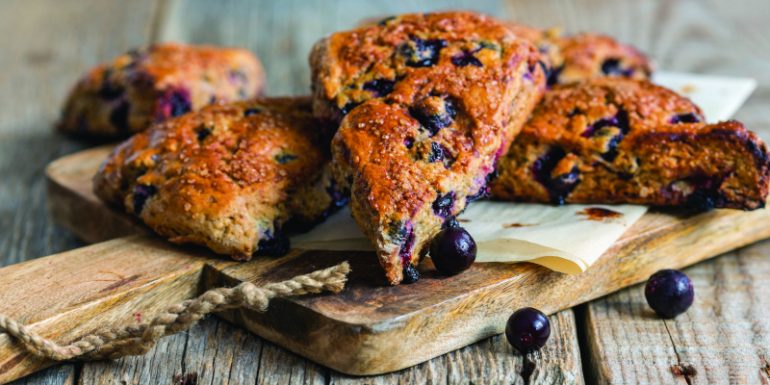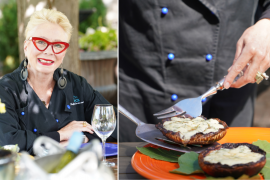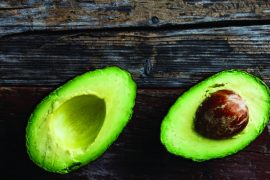By Bill Turner
My editor suggested that I write an article on scones. She was thinking colder weather, the warm and cozy feeling of something baking in the oven, maybe something nice and hot to drink. Hmm … not a bad way to spend a cold, gray winter afternoon.
Strangely, my thoughts drifted back to my high school days and what would have happened if I told my buddies that I wanted a scone. There would have been pushing and shoving. I would have been the endless butt of jokes for days, with pinkies sticking out in the air as if holding some imaginary cup of tea. I can hear them asking, oh so sweetly, if I wanted some clotted cream or maybe some petit fours.
As I emerged from this reverie, I realized that today scones have become a ubiquitous snack food. Starbucks will have three or four varieties and even Dunkin’ Donuts has them. It all goes to show that Bob Dylan (now a Nobel Prize winner for literature) is right: “The times they are a changing.” And change can be for the good. After experimenting with a couple of recipes I realized that my high school buddies didn’t know what they were missing.
So, why try to make these things at home; why not just go to the store? The first and most important answer is scientific. These wonderful treats are only good for about eight hours. They go stale very quickly, but if they are fresh out of the oven at home they are an incredible treat. You don’t even want to guess how long some of the ones you see in airports have been sitting around.
The second reason to make them at home is that you can experiment with endless varieties until you come up with your own signature recipe. You can give it a special name like “Bob’s Big Bonanza Scone,” or something equally silly.
Scones are easy to make. Get all of the ingredients out on the counter in front of you and then time yourself. You should have the scones in the oven in under 15 minutes.
There are two major varieties of scones — sweet and savory. Sweet scones are sometimes plain and are served with clotted cream and jam. However, they will often have nuts, berries and sometimes chocolate. Savory scones often have bacon, sausage, ham, cheese, or any combination of these. Below are some of my favorite recipes. We will start with the basic recipe and then learn how to add other things for more exotic creations.
QUEEN VICTORIA’S BASIC SCONE RECIPE
This is meant to be served with clotted cream and jam (or butter and jam) at exactly 4 p.m.
THE GEAR
- Mixing bowl
- Baking sheet
- Parchment paper
THE INGREDIENTS
- 3 cups of flour (Anything will work, but bread or cake flour will produce a lighter result.)
- 1 Tbsp. baking powder
- 2 Tbsp. sugar
- ½ tsp. salt
- 4 Tbsp. butter (½ stick)
- 2 eggs
- 1 Tbsp. vanilla extract
- 1 cup heavy cream (use milk if you wish)
THE DIRECTIONS
Preheat the oven to 425 degrees F.
- In a mixing bowl, combine the dry ingredients.
- Cut the butter into small chunks and combine with the flour mixture using your hands. You want a lumpy oatmeal texture, but it’s not a problem if there are some small uncombined pieces of butter left.
- Whisk together the eggs, vanilla and cream. Add to flour mixture and stir for about 30 seconds until the batter barely holds together.
- Gather the dough with your hands and divide in two equal pieces. Form each into a disc that is about ¾ inch thick.
- Place the discs on the baking sheet which is lined with parchment paper. Cut each disc into eight triangles and gently pull them apart from the center so that there is a ½ inch gap between the pieces.
Bake for 15 minutes and check to see if edges are getting brown. If not, bake for another 3-5 minutes. Do not overbake – you’ll have rocks instead of scones.
SWEET SCONE VARIATIONS
The current trend is to add fruits, nuts and chocolate to the basic scone recipe. For example, you can add one cup of nuts or chocolate chips and one cup of berries such as blueberries, courants, raisins or dried cranberries to the flour mixture (step two above). This may seem like a lot to add, but it disappears easily in the batter. Let kids help with the recipe and let them choose the ingredients.
For a great topping, brush the tops of the scones with milk. Then mix together ¼ cup of sugar and 1 Tbsp. of cinnamon and sprinkle over the top before baking.
SAVORY SCONE RECIPE
There are some really interesting recipes for savory scones. I suspect that this is an American invention, especially since many of the common recipes come from Southern Living magazine or the Food Network’s
Diners, Drive-Ins and Dives (one of my favorite shows). These variations don’t really fit with English tea at 4 p.m. Instead, they are more suited for breakfast or lunch.
THE DIRECTIONS
Start with Queen Victoria’s basic recipe (above) and do the following:
- Add six ounces of any cheese (cheddar, feta, gouda, goat, blue, Swiss, etc.) to the flour mixture.
- Add eight ounces of bacon, ham or sausage to the dry flour mixture (step 2 at left). For bacon, cut crosswise in ½ inch pieces and cook until reasonably crispy before adding. For sausage, break into small pieces and cook before adding. For ham, dice before adding.
- Add some chopped fresh spices like parsley, cilantro, chives or basil.
There are endless variations. You can eliminate the meat and substitute diced apple or pear. Or, skip the meat and add chopped fresh spinach (best with feta cheese) or even kale. Enjoy!





